Key takeaways:
- Engaging young voices in gender equality advocacy is essential for fostering innovation and driving meaningful change.
- Creating inclusive platforms requires intentionality, ensuring diverse voices are heard and valued in advocacy efforts.
- Sharing personal experiences empowers youth and enhances empathy, sparking broader conversations about gender issues.
- Measuring the impact of advocacy goes beyond participation rates to include shifts in attitudes and personal testimonials of empowerment.
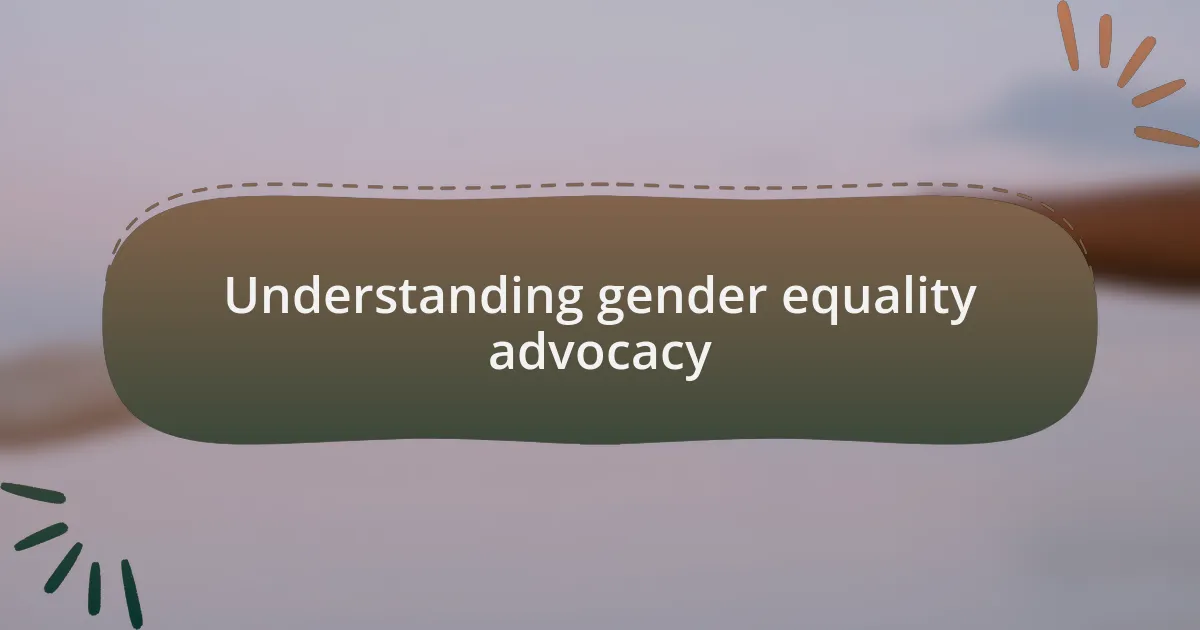
Understanding gender equality advocacy
Understanding gender equality advocacy goes beyond simply promoting fairness; it’s about amplifying voices that have been historically marginalized. I remember attending a community meeting where young activists passionately shared their stories of discrimination. Hearing their raw experiences made it clear that gender equality advocacy is built on real-life narratives that resonate with our shared humanity.
Consider for a moment how often we overlook the power of young voices in this dialogue. In my experience mentoring youth, I’ve seen how their perspectives can challenge outdated norms and spark meaningful change. It’s inspiring to witness an 18-year-old articulate the struggles they face due to gender bias, reminding us all that advocacy starts with listening to those directly affected.
What does it mean to foster an environment where everyone feels seen and heard? Engaging young voices in gender equality advocacy isn’t just beneficial; it’s essential. They bring fresh ideas and insights that can transform strategies and tactics, ultimately pushing the boundaries of what gender equity looks like today. When we prioritize their involvement, we’re not only validating their experiences but also ensuring a more inclusive future for all.
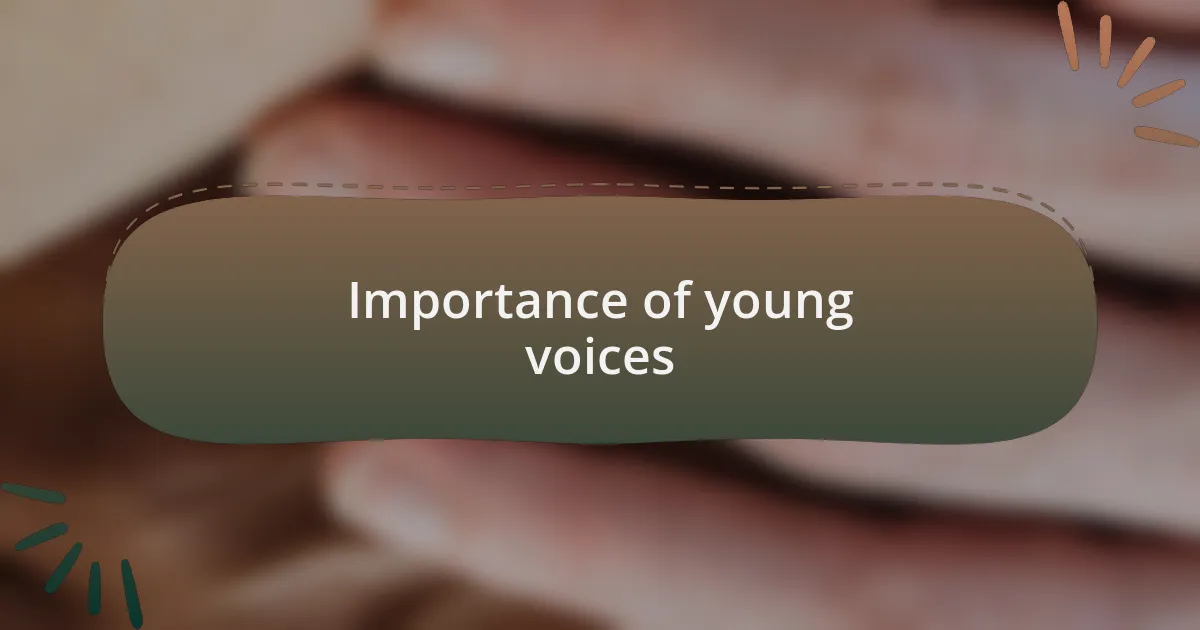
Importance of young voices
Young voices are vital in the dialogue around gender equality because they fundamentally reshape our understanding of the issues at hand. Reflecting on a time when I facilitated a workshop with young activists, I was struck by their fearless engagement. They challenged me with questions I hadn’t considered—like, “Why should we wait for the ‘right’ moment to speak up?” Their urgency and passion highlighted that change doesn’t have an age limit; rather, it thrives on the boldness of youth who refuse to stay silent.
Moreover, incorporating the insights of younger generations into our advocacy efforts is crucial, as they often confront gender issues in unique and evolving contexts. One afternoon, while chatting with a group of teens, one shared how online platforms had become both a source of empowerment and a battleground for gender equality. This conversation helped me see that their narratives are not just relevant; they are essential for crafting strategies that resonate with the present and future.
When I reflect on these experiences, it’s clear that young voices bring an authenticity that can drive change in a way that older perspectives sometimes miss. Their stories cut through the noise, reminding us that personal experiences are the foundation of effective advocacy. So, why should we hesitate to listen and learn from them? The truth is, embracing their voices is not just about supporting them; it’s also about enriching our own understanding of the gender equality movement.
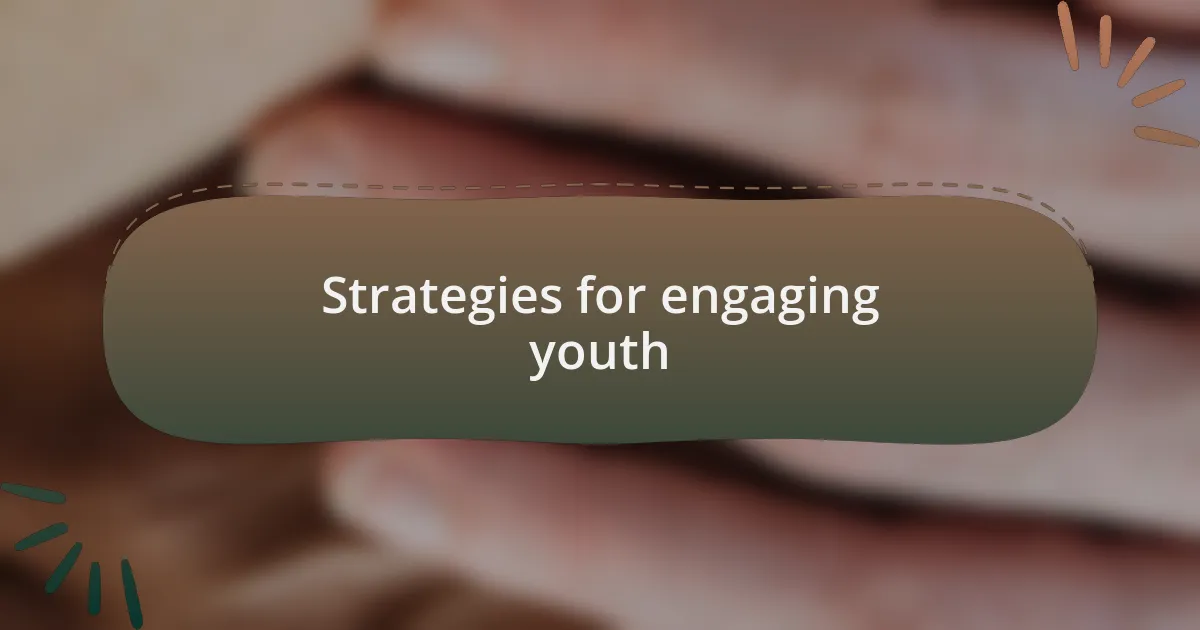
Strategies for engaging youth
Engaging youth in gender equality advocacy requires creating spaces where their voices are heard and valued. I remember organizing a local youth forum where we invited young people to share their perspectives on gender issues in a safe environment. The result was astonishing; watching them articulate their thoughts and challenge societal norms reminded me that they possess a depth of insight that can drive innovation in our initiatives.
Another effective strategy is to leverage social media platforms, which resonate with younger audiences. I once collaborated with a group of high school students to launch a campaign on Instagram focused on gender stereotypes. As they shared their own stories, I was amazed at the ripple effect it created—others began sharing their experiences too, igniting conversations that spread far beyond our local community. This demonstrated how digital engagement amplifies their voices and transforms passive observations into active dialogues.
Moreover, mentorship plays a crucial role in fostering commitment among young advocates. By providing guidance and support, I’ve seen firsthand how youth can flourish as leaders. I recall mentoring a young activist who later organized her own event, empowering peers to speak on their experiences with gender bias. Her success underscored the potential of structured support in cultivating the next generation of change-makers. How can we facilitate similar growth in more youth? It starts with our willingness to invest time and resources into their potential.
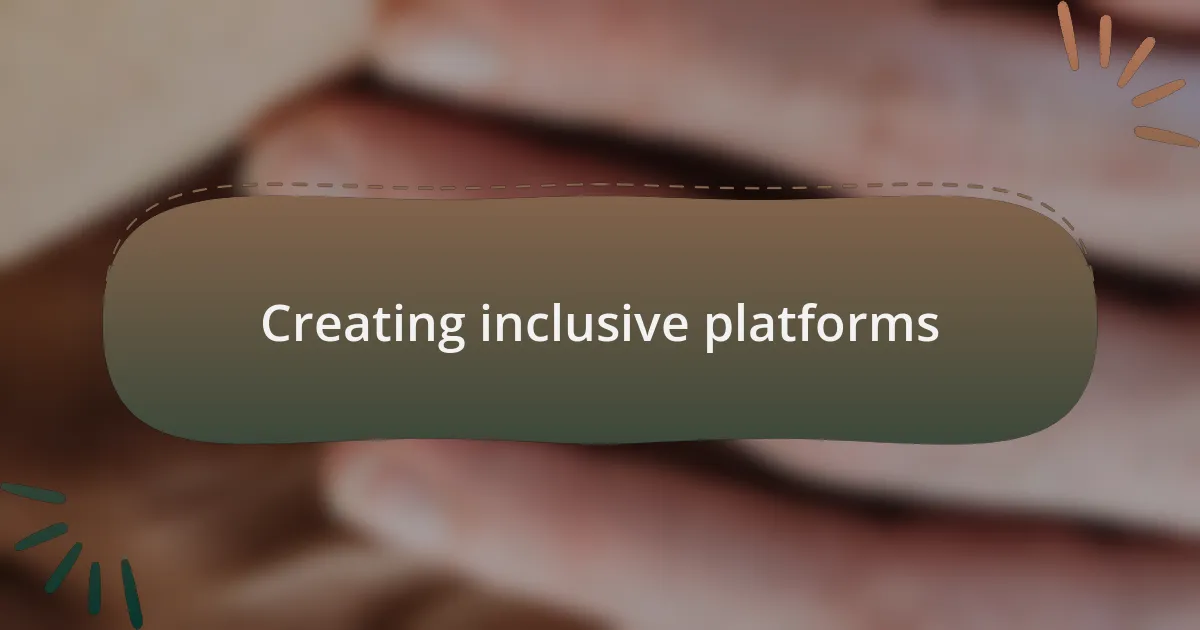
Creating inclusive platforms
Creating inclusive platforms requires intentionality and awareness of diverse voices. I recall attending a youth-led event where participants from various backgrounds shared their experiences and challenges. Hearing a young refugee speak about her struggles while navigating cultural norms in a new country was profoundly moving. It reminded me that inclusivity isn’t just about numbers; it’s about creating spaces where every voice contributes to the dialogue.
I once facilitated a workshop aimed at developing an online platform for youth to express themselves about gender equality. As the participants brainstormed ideas, I observed how their varied perspectives enriched our discussions. One young man proposed a podcast where they could engage in real conversations about their experiences. His enthusiasm sparked a lightbulb moment for everyone, showing how inclusivity can lead to innovation and creative solutions.
Inclusive platforms also thrive when we prioritize accessibility. I remember a project where we adapted educational materials for young people with disabilities. It was eye-opening to see how ensuring that everyone can participate opened up conversations that we hadn’t anticipated. When we ask ourselves how we can break down barriers, we help build a community where every young voice has the chance to be heard and valued.
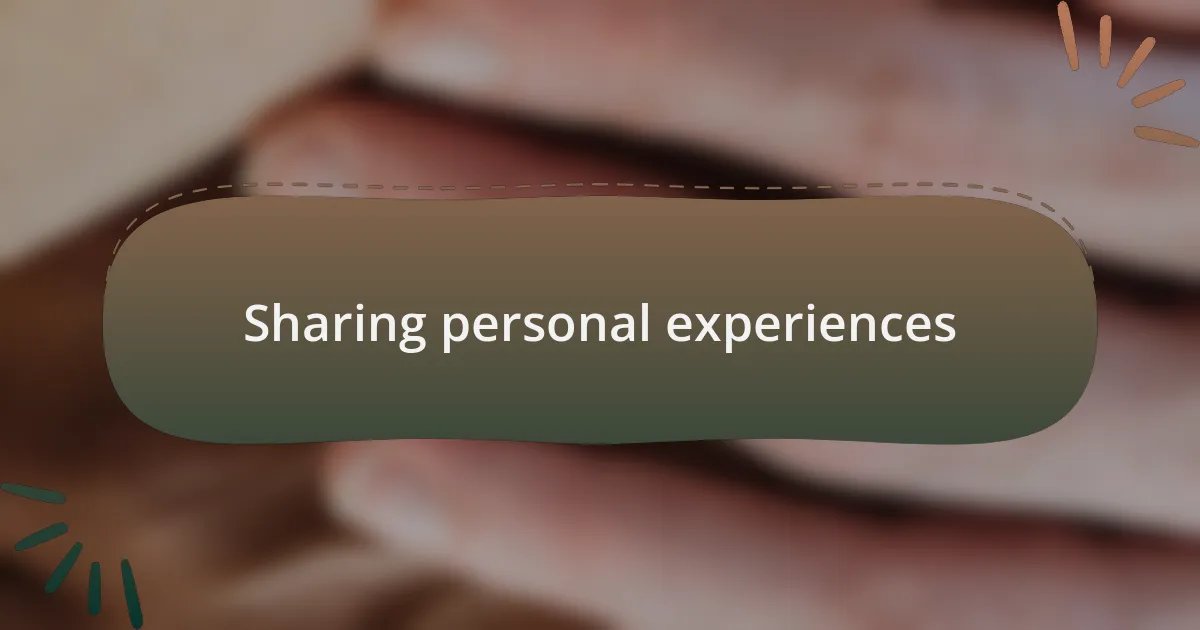
Sharing personal experiences
Sharing personal experiences can be a transformative way to empower young voices. I vividly recall a conversation with a high school student who felt unheard in her own community. As she opened up about her journey, including the backlash she faced while advocating for equal rights, I saw a shift in her confidence. It struck me how sharing her story not only validated her feelings but also inspired others to embrace their narratives.
During another initiative, I had the privilege of listening to a young activist discuss her experiences with gender bias in her school. As she spoke, I couldn’t help but wonder, how many others faced similar challenges but remained silent? Her bravery in sharing shed light on issues that often go unnoticed, reminding me that personal stories have this incredible power to ignite conversations and foster empathy.
I often think about a community event I attended, where young individuals expressed their personal challenges through art and performance. One participant used a spoken word piece to convey her struggles with societal expectations. As the audience listened, I sensed a collective understanding blossoming among us, bridging gaps that words alone couldn’t. Isn’t it remarkable how personal experiences can connect us, sparking a reflection on our own lives and encouraging an open dialogue?
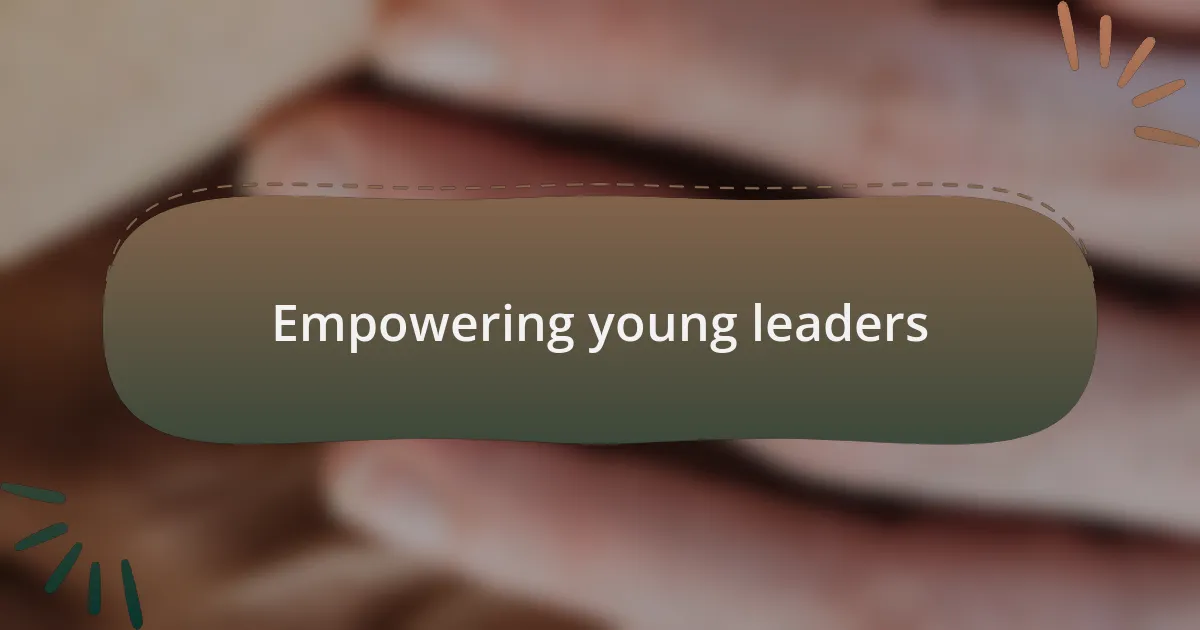
Empowering young leaders
Empowering young leaders can take many forms, and I remember attending a youth leadership summit that truly opened my eyes. There, a shy young man took the stage to present his vision for a more inclusive community. His voice trembled at first, but as he spoke about his experiences with exclusion, I saw him transform. It made me realize how important it is to create spaces where young people can share their ideas without fear of judgment.
During a mentorship program I led, I encountered a group of passionate students eager to discuss gender equality. One young woman stood out as she fearlessly proposed an initiative to raise awareness about sexual harassment in schools. Her enthusiasm was infectious, and as I watched her galvanize her peers, I couldn’t help but reflect on how cultivating leadership qualities in young individuals sets the stage for transformative social change. Have you ever felt inspired by someone who just took the lead? It’s often those raw moments of courage that spark movements.
In my experience, when we empower young leaders, we create a ripple effect throughout the community. At one workshop, a participant shared her goal of starting a podcast to highlight the stories of marginalized voices. The energy in the room shifted as others began brainstorming alongside her, highlighting the importance of collaboration. It’s fascinating how one young leader’s vision can inspire collective action, affirming the belief that each voice matters in the fight for equality.
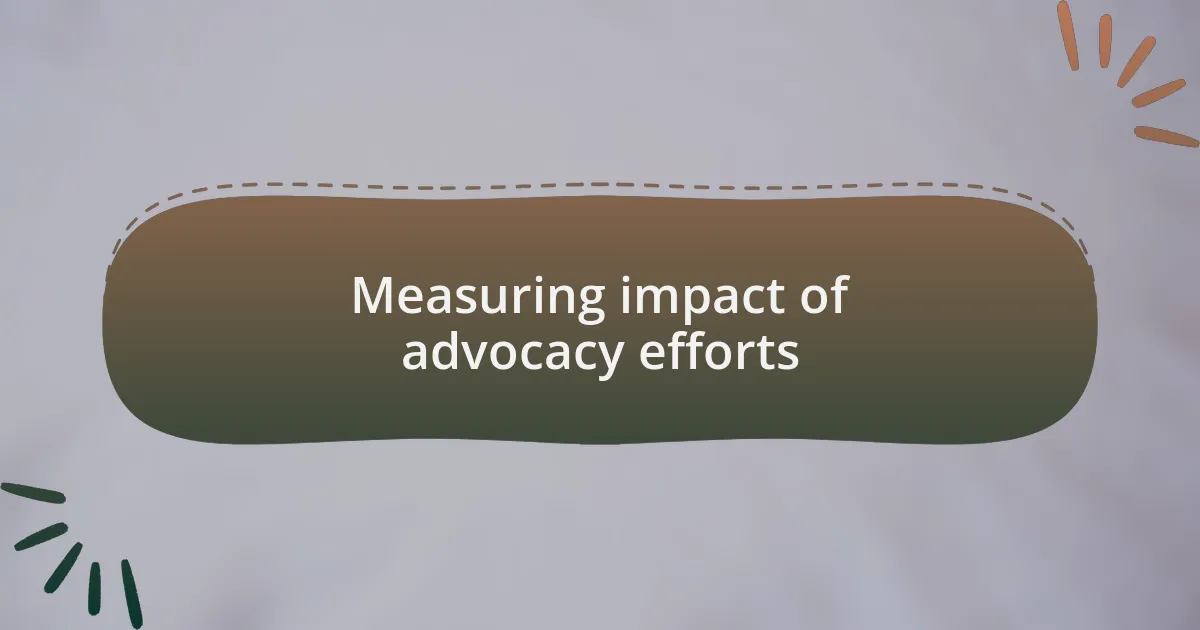
Measuring impact of advocacy efforts
Measuring the impact of advocacy efforts is often more complex than one might think. For instance, when we launched a campaign to promote gender equality in schools, we decided to track not just participation rates but also the shifts in attitudes among students. I vividly remember hearing from teachers who noted changes in classroom discussions that reflected deeper understanding and respect for different perspectives. Isn’t it amazing how tangible change can often stem from intangible shifts in mindset?
Another layer of measurement involves gathering qualitative feedback. During a recent initiative, I encouraged young advocates to reflect on their experiences and share personal testimonies. One young man recounted how he felt empowered to challenge gender stereotypes at home after attending our workshop. His story was a reminder that the metrics we often rely on can miss the profound emotional transformations that occur within individuals. Can we truly quantify the empowerment of a single voice that ignites others?
Lastly, establishing long-term impact means revisiting our goals and assessing if they still resonate with the community served. I learned this firsthand when revisiting a project aimed at fostering confidence in young women. The initial feedback was encouraging, but months later, I asked them how their lives had changed. Many expressed a newfound sense of agency and responsibility to advocate for others, which is perhaps the ultimate measure of success. How refreshing it is to see advocacy efforts evolve and take root in unexpected ways!